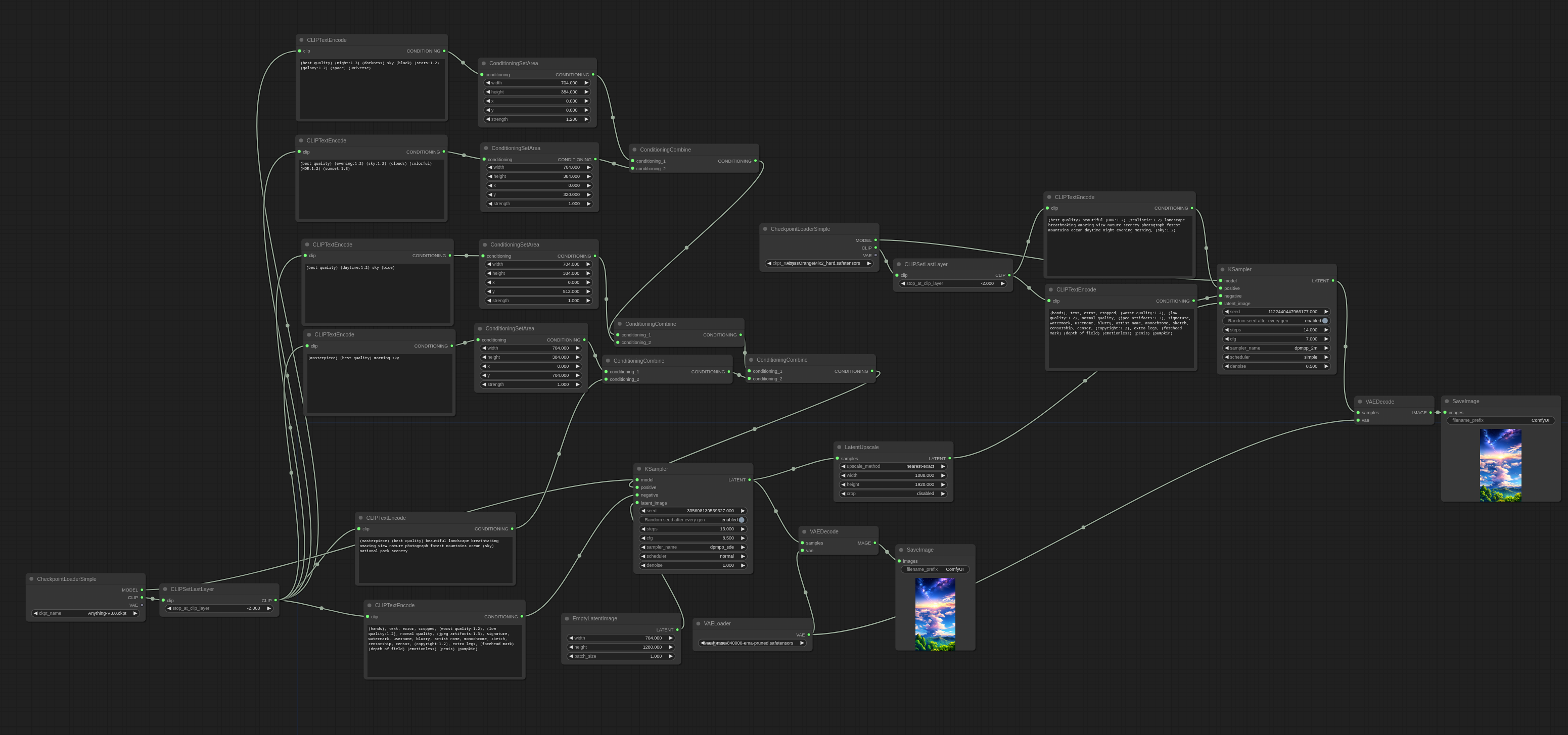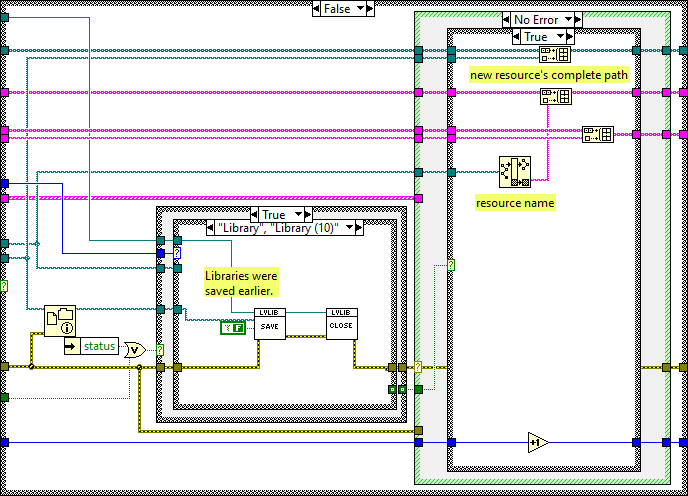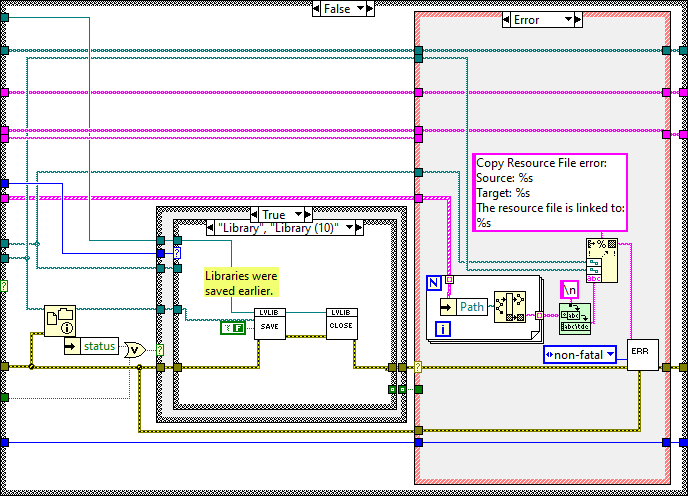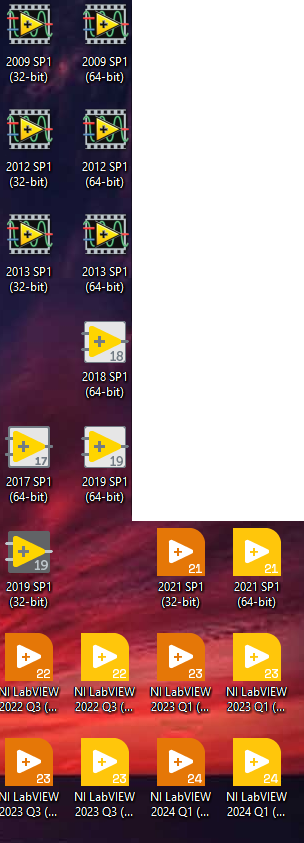-
Posts
4,987 -
Joined
-
Days Won
311
Content Type
Profiles
Forums
Downloads
Gallery
Everything posted by ShaunR
-

OpenG LabVIEW Zip 5.0.0-1 - stuck at the readme
ShaunR replied to PA-Paul's topic in OpenG General Discussions
I think we are talking past each other. I don't have a problem with naming. That is just what the *.* stuff does. I'm interested in what Rolf is doing to put the *.* into the node paths. I have a problem with linking-the VI search popping up during installation, VIPM not compiling everything and asking the user to save after use. This is caused by VIPM setting in concrete, the full DLL path in the nodes when it builds and not compiling certain VI's after installation. -

OpenG LabVIEW Zip 5.0.0-1 - stuck at the readme
ShaunR replied to PA-Paul's topic in OpenG General Discussions
Both binaries can be in the same directory. No need for a Post Install or Post Uninstall. No code required to choose a 32 bit or 64 bit binary in the the different LabVIEW bitnesses. There are excellent reasons to use this nomenclature but they are thwarted by VIPM. -

OpenG LabVIEW Zip 5.0.0-1 - stuck at the readme
ShaunR replied to PA-Paul's topic in OpenG General Discussions
Not quite. I asked about your code to solve my issue. I offered what I thought was an improvement based on my requirements and, as I don't support Linux or Mac anymore, you could migrate it to the other systems if it was viable. You don't like it. Fine. It works great for me but for one edge case that you have pointed out that doesn't affect me. Assuming I cannot solve that one edge case, then I have a general Windows solution with one caveat that can go in the documentation. I'd call that progress -

OpenG LabVIEW Zip 5.0.0-1 - stuck at the readme
ShaunR replied to PA-Paul's topic in OpenG General Discussions
It's not a problem I have. I name them x32 and x64, if necessary, so there is no issue with the likes of user32.dll. What I do have a problem with is binaries which can be 32 or 64 bit but there is no indication in the name and the path gets "fixed" by VIPM (similar problem with TPLAT). In that scenario I want the ".*" on the end only. That is the problem it is solving and why I said I wasn't sure about the full path (I think I want just the filename). Until now I have had a similar solution to you (force changes in Post_Install and make LabVIEW search for the binaries so linking them on first load). The main difference in my solution is, perhaps, that Post_Install has the binaries in arrays on the BD and the correct bitness is saved out when installed by the user. I wanted something where I didn't update the Post_Install every time binaries changed. Perhaps we are solving different issues due to different workflows. -

OpenG LabVIEW Zip 5.0.0-1 - stuck at the readme
ShaunR replied to PA-Paul's topic in OpenG General Discussions
Feel free to add them in. -
The comfyUI nodes are described by JSON in files called "Workflows" so we could import them and use scripting to create nodes. That's if we want parity. But we could support nesting which ComfUI wouldn't understand. The WebUI's are just interfaces to create REST requests which we can easily do already. I'm just trying to find a proper API specification or something that enables me to know the JSON format for the various requests. Like most of these things, there are just thousands of Github "apps" all doing something different because they use different plugins. Modern programmers can do wonderful things but it's all built on tribal knowledge which you are expected to reverse engineer. The only proper API documentation I have found so far is for the Web Services which isn't what I want - I'm running it locally.
-
I've been playing around with an A.I. Imaging software called Stable Diffusion. It's written in Python but that's not the part that interests me... There are a number of web browser user Interfaces for the Stable diffusion back-end. Forge, Automatic 1111, Comfy UI - to name a couple - but the last one, comfy UI, is graphical UI. The ComfyUI block diagram can be saved as JSON or within a PNG image. That's great. The problem is you cannot nest block diagrams. Therefore you end up with a complete spaghetti diagram and a level of complexity that is difficult to resolve. You end up with the ComfyUI equivalent of: The way we resolve the spaghetti problem is by encapsulating nodes in sub VI's to hide the complexity (composition). So. I was thinking that LabVIEW would be a better interface where VI's would be the equivalent of the ComfyUI nodes and the LabVIEW nodes would generate the JSON. Where LabVIEW would be an improvement, however, would be that we can create sub VI's and nest nodes whereas ComfyUI cannot! Further more, perhaps we may have a proper use case for express VI's instead of just being "noob nodes". Might be an interesting avenue to explore to bring LabVIEW to a wider audience and a new technology.
-

OpenG LabVIEW Zip 5.0.0-1 - stuck at the readme
ShaunR replied to PA-Paul's topic in OpenG General Discussions
I've modified your sub vi to check the actual file bitness (I think). If you target user32.dll, for example, the filename out is user32.* - which is what's expected. I need to think a bit more about what I want from the function (I may not want the full path) but it should fix the problem you highlighted (only in Windows ). Fixup Shared Library Name.vi -

OpenG LabVIEW Zip 5.0.0-1 - stuck at the readme
ShaunR replied to PA-Paul's topic in OpenG General Discussions
Yes. The path isn't passed through but I figured out what it was supposed to be. this is the one in my installation: It's a trivial change though. The important part is the adding the extra case and your new VI. I was about to go all Neanderthal on the "Write Linker Info" before you posted the proper solution. -

OpenG LabVIEW Zip 5.0.0-1 - stuck at the readme
ShaunR replied to PA-Paul's topic in OpenG General Discussions
Sweet. It's not quite the same but I'll figure the rest out. You've done the hard part Thanks. -

OpenG LabVIEW Zip 5.0.0-1 - stuck at the readme
ShaunR replied to PA-Paul's topic in OpenG General Discussions
There is a "Copy Resource Files and Relink" in "<program files>\JKI\VI Package Manager\support\ogb_2009.llb" and "<program files>\JKI\VI Package Manager\support\ogb_2017.llb". Is it "Write Linker Info from File__ogb.vi" that you have modified? I'll have to have a closer look. -

OpenG LabVIEW Zip 5.0.0-1 - stuck at the readme
ShaunR replied to PA-Paul's topic in OpenG General Discussions
Can the JKI builder be modified to do this? I've already hacked some of their VI's in ogb_2009.llb so it didn't take 6 hrs to build. It's a huge problem for me when building. I have a solution that sort of works, sometimes, but not a full proper solution. Can you detail your process? -
Welcome back. Retirement not all it was cracked up to be? My only comment about this (because I still use LV 2009-best version ever) is that generally: Never do it in the middle of a project. Upgrading LabVIEW is a huge project risk. Don't upgrade if the software already works and you are adding to it (only use it on new projects). Only upgrade if everyone else in your team upgrades at the same time. Upgrade if there are specific features you cannot do without. Upgrade if it will greatly reduce the time to delivery (unlikely but it has been known). Upgrade if there is a project stopping bug that is addressed in the upgrade you are considering. Remember that you can have multiple versions on the same machine. You don't need (and should never) go and recompile all your old projects.
-
Nobody has met me, right? I might be A.I. without the I
-
Ask it how I can get past the sign-up CAPTCHA to use it?
-
I have the binaries as arrays of bytes in the Post Install. I convince VIPM to not include the binary dependency and then write out the binary from the Post Install. You can check in the Post install which bitness has invoked it to write out the correct bitness binary. Not sure if that would work on Linux though.
-
Installing both binaries huh? Don't blame you. It takes me forever to get VIPM to not include a binary dependency so I can place the correct bitness at install time with the Post Install (64bit and 32bit have the same name. lol)
-
The longer it is unresolved, the less likely users will bother to return. I used to check the forums every day. Now it is every couple of weeks. Soon it will be never. Some might see that as a bonus
-
The objection is that I (as a user) do not have end-to-end encryption (as advertised by the "https" prefix) and there is no guarantee that all encryption is not stripped, logged and analysed before going on to the final server. But that's not just a single server, it's all servers behind Cloudlfare, so it would make data mining correlation particularly useful to adversaries. Therefore I refuse to use any site that sits behind Cloudflare and my Browsers are configured in such a way that makes it very hard to access them so that I know when a site uses it. If I need the NI site (to download the latest LabVIEW version for example) then I have to boot up a VM configured with a proxy to do so. I refuse to use the NI site and the sole reason is Cloudflare. So now you know how you can get rid of me from Lavag.org - put it behind Cloudlfare
-
Any site that uses Cloudflare is completely safe from me using it. As far as I'm concerned it is a MitM attack.
-
Not exactly a software solution though. I wrote a plugin for my CMS that uses Project Honeypot so it's not that difficult and this is supposed to be a software forum, right? The problem in this case, however, seems to be that it's an exploit-it needs a patch. Demoting highly qualified (and expensive) software engineers to data entry clerks sounds to me like an accountants argument (leverage free resource). I'd rather the free resource was leveraged to fix the software or we (the forum users) pay for the fix. The sheer hutzpah of NI to make you a no-cost employee to clear up their spam is, to me, astounding. What's even more incomprehensible is that they have also convinced you it's a privilege
-

Why doesnt TCP listen listen to my IP address
ShaunR replied to govindsankarmr's topic in LabVIEW General
Port 139 is used by NetBIOS. The person in the video is using port 8006 which is not used by any other programs. -
By now, you really shouldn't have to be deleting them manually. If it's an exploit then it should have been patched already (within 24hrs is usual). If it's just spam bots beating CAPTCHA then maybe we can help with a proper spam plugin (coding challenge?). This is a software engineering forum and if we can't stop bots posting after a week then what kind of software engineers are we? It's also quite clear to me that this is no more than a script kiddie. You can watch the evolution of the posts where originally they had unfilled template fields that, as time went on, became filled.
-










